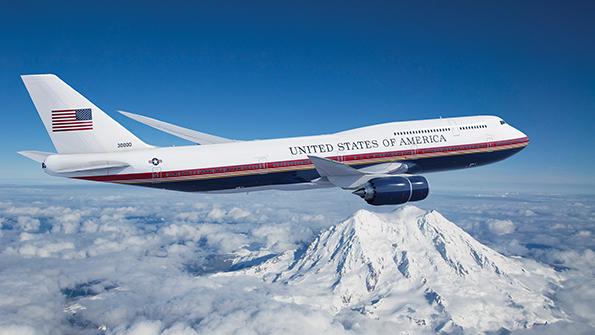
The U.S. Air Force has not made a final decision on the 747-8I livery scheme, although this rendering depicts it as the VC-25B.
The Queen of the Skies is no longer in production, but a few more remain to be delivered. In the second quarter of fiscal 2026, the U.S. Air Force expects to launch operations with two newly handed over VC-25Bs, the presidential airlift derivative of the 747-8.
The Air Force also may acquire between six and eight more 747-8s as Boeing E-4B replacements starting in 2029. The service is seeking a commercial-derivative, very large, four-engine aircraft to serve as the Survivable Airborne Operations Center. By 2029, of course, the 747-8 production system will have been shut down for six years, so deliveries of used widebody aircraft are more likely, although the Air Force has kept its specific plans for the so-called Doomsday aircraft secret.
- New presidential airlift aircraft to enter service in 2026
- E-4B replacement is scheduled to start in 2029 but likely with used aircraft
The U.S. military has a long tradition of launching and sustaining derivatives of Boeing commercial aircraft, and the latest version of the 747-8 is no exception. Boeing derived the commercial 707 from the slightly narrower cross-section of the Air Force’s KC-135 tanker. An Air Force order for 737-derived T-43s in 1972 rescued the then-struggling narrowbody from potential cancellation, keeping deliveries flowing until a fresh batch of orders arrived in 1974, mainly from African carriers.
An Air Force order for 179 Boeing 767-based KC-46s in 2011 has cost the company $6.5 billion so far in contract overruns, but the tanker program has kept the production line healthy in time for an influx of 767 Freighter orders over the last five years.
By contrast, the presidential airlift fleet, which uses the call sign “Air Force One” when the commander-in-chief is on board, is a mark of corporate prestige for Boeing. The last two 747-200s that rolled off the assembly line in Everett, Washington, became VC-25As, which are now due for replacement 30 years later.
Outwardly, the VC-25B is to resemble the 747-8I passenger model of the GEnx-2B-powered Boeing widebody, but many of the internal systems and structures should be unrecognizable.
Under a $4.9 billion program, excluding nearly $1.94 billion in cost overruns absorbed on Boeing’s balance sheet, the Air Force is converting the passenger jets into VVIP aircraft that also could serve as airborne military command centers during a war.
Major modifications for the presidential mission start with an electrical power upgrade, including the addition of a second auxiliary power unit—both units could be activated during flight. Boeing also is adding a mission communications system, an undisclosed self-defense system and military-hardened avionics.
The VC-25Bs will not require local infrastructure, allowing the passengers and crew to board and exit the aircraft independently. No operational changes are expected from the VC-25A, so the VC-25B will need a special navigator station in the cockpit, which enables the aircraft to be guided even if ground-based navigation aids were destroyed during a nuclear war.
In an attempt to save costs, the Air Force deleted a requirement for inflight refueling, so although they are expected to be significantly more fuel-efficient the CF6-80C2-powered VC-25As, the presidential airlift replacements will need to land to refuel much sooner on certain missions.
The service also tried to save costs on the program by acquiring two white-tail 747-8Is built for Russian carrier Trans-aero, which went bankrupt shortly before a scheduled delivery in 2015.
Despite those efforts, the VC-25B development and modification program is nearly $2 billion over budget and 17 months behind schedule. Boeing originally selected Texas-based GDC Technics to supply the interiors, but the relationship broke down in a legal dispute that led to the supplier’s bankruptcy in 2021. One of the aircraft reportedly was damaged during the modification process, requiring costly repairs and extra time to complete.
An Air Force spokesperson declined to identify the supplier that replaced GDC Technics, saying the information is secret. Ed Balet, Boeing’s deputy program manager for the VC-25B, says on his LinkedIn page that he has facilitated the onboarding of Greenpoint Technologies as the new interiors integrator since 2021. Greenpoint teamed up with Boeing in 2011 to develop a commercial VIP interior for 747-8Is.





